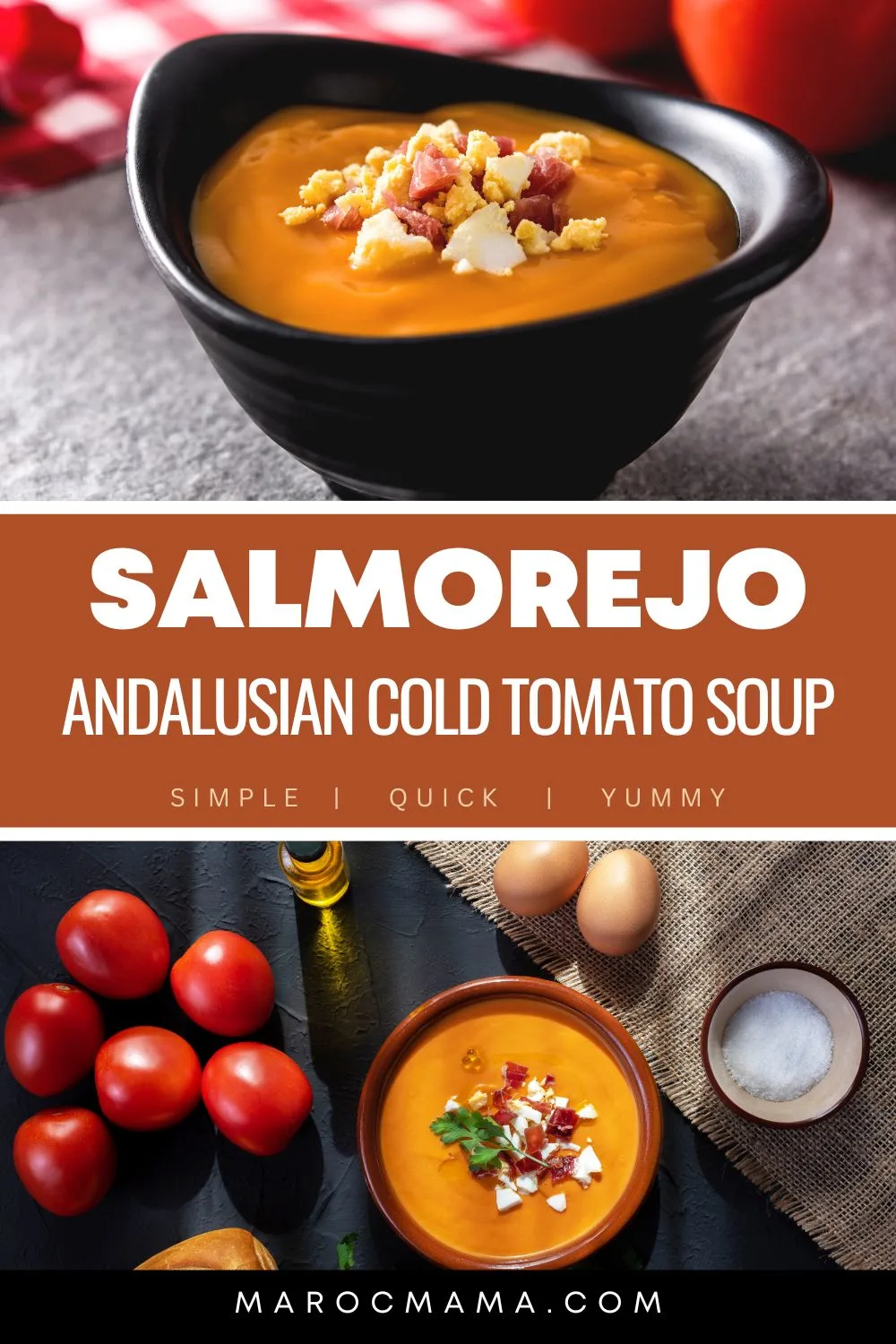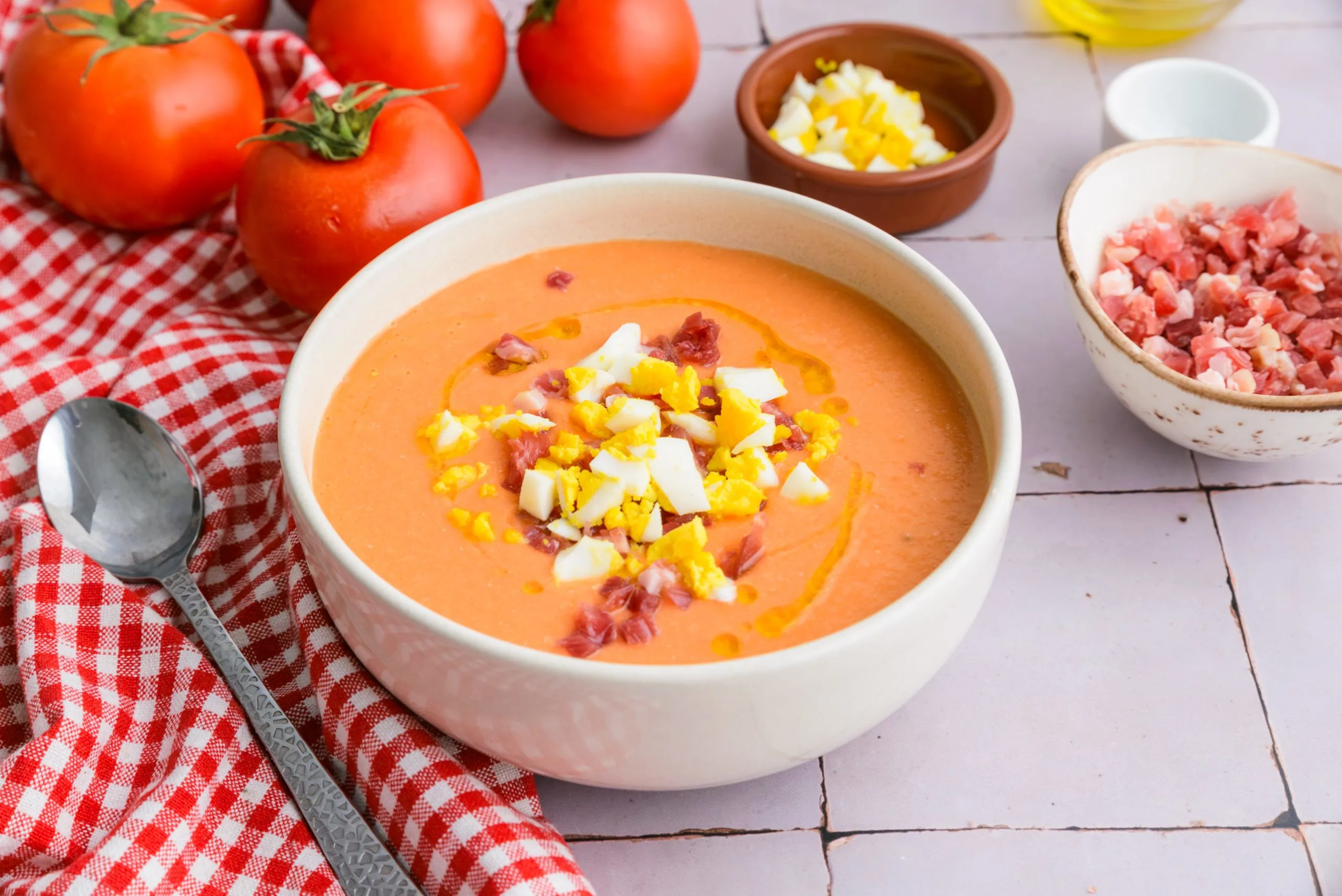No this is not gazpacho, Salmorejo soup is one of the most popular cold soups from the Andalusia region of Spain. To be honest, I wasn’t really sure what to make of it at first. But when it comes to easy Spanish recipes – this is by far one of the easiest.
I’m not a huge fan of cold soups but the first time I sipped this in Seville at Easter time, I was hooked. I later took a cooking class and learned that there are many kinds of cold soups and they’re mostly served in summer – which makes a lot of sense.

What is Salmorejo?
This cold tomato soup is said to have originally come from Mesopotamia and landed in Cordoba which is now considered it’s “hometown.” Like many foods from this region, it really is very simple using ingredients that are easily accessible and/or food items that might otherwise go to waste.
Because the ingredients are so simple it’s important to have really good things to start with. Use the best quality olive oil you can and the tastiest tomatoes – this is what will go a long way in creating a memorable dish, whether it’s a cold Spanish soup or any other culinary creation.
A final note, the texture of this Andalusian tomato and bread soup should be a bit thick and not watery. The bread will help make this consistency but adding too much olive oil or trying to add water to thin it out will change the consistency.

Once you have the base mastered you can play with the topping ingredients. You could even make a salmorejo topping bar for your next party, featuring the delightful flavors of Andalusian soup.
What’s the Difference Between Gazpacho and Salmorejo?
Gazpacho and salmorejo are quintessential examples of traditional Spanish cuisine, both beloved for their refreshing flavors and coolness, particularly during the scorching summer months.
Gazpacho, originating from southern Spain, boasts a lighter and more liquid consistency, akin to a chilled vegetable soup, commonly referred to as a Spanish cold soup. Its base ingredients typically include tomatoes, peppers, cucumbers, onions, garlic, bread, vinegar, and olive oil, all blended together into a smooth concoction before being chilled.
This iconic dish is often served as a starter or appetizer, offering a delightful burst of flavor with every spoonful. Throughout Andalusia, especially in regions like Seville and Malaga, gazpacho remains a cherished culinary tradition, celebrated for its simplicity and refreshing qualities.
In contrast, salmorejo hails from Cordoba, another region in Andalusia, and distinguishes itself with its thicker and creamier texture, resembling a velvety purée rather than a liquid soup. The base ingredients of salmorejo primarily consist of tomatoes, bread, garlic, and olive oil, blended together into a rich and satisfying mixture.

Unlike gazpacho, salmorejo is not strained, allowing its texture to remain hearty and substantial. Often served in a bowl, garnished with hard-boiled eggs and finely diced jamón, salmorejo is a hearty and fulfilling dish, perfect for savoring as a light meal on a warm summer’s day.
Despite their differences, both gazpacho and salmorejo reflect the vibrant culinary heritage of Spain, showcasing the country’s penchant for fresh, seasonal ingredients and innovative flavor combinations.
Make Great Salmorejo with These Ingredients
When preparing salmorejo, an Andalusian tomato soup, attention to detail is key to achieving the perfect balance of flavors and textures. Firstly, prioritize the quality of your ingredients. Opt for ripe, flavorful tomatoes and high-quality extra virgin olive oil, as these form the foundation of the soup’s taste.
Secondly, consider the importance of seasoning and chilling. Season the soup with garlic, salt, and vinegar according to your taste preferences, starting with small amounts and adjusting as needed. It’s crucial to taste as you season to achieve the desired flavor profile. Once blended, refrigerate the Salmorejo for several hours or overnight.

Chilling allows the flavors to meld together, resulting in a more harmonious taste. Moreover, serving the soup well-chilled enhances its refreshing qualities, making it an ideal dish for hot summer days.
Try These Other Easy Soup Recipes
Here are some other easy soup recipes you can try.
- The Ajo Blanco Soup, a chilled almond soup originating from Spain. Its creamy texture and refreshing taste make it a perfect choice for warm weather.
- If you’re in the mood for something hearty and full of flavor, give Vegetarian Moroccan Harira a try. This traditional Moroccan soup is loaded with lentils, chickpeas, and aromatic spices, making it both nutritious and satisfying.
- For a taste of the Middle East, whip up some Lebanese Shorbat Adas, a comforting lentil soup recipe. Its simple yet delicious combination of lentils, onions, and spices will warm you up from the inside out.
These soup recipes offer a delightful culinary journey with minimal effort, perfect for any day of the week.
How to Make Salmorejo – An Andalusian Soup Recipe

Salmorejo - Andalusian Cold Tomato Soup
A popular tomato based cold soup that is eaten during summer months.
Ingredients
- 750 grams peeled tomatoes
- 1 garlic clove
- (1) 100 gram soft bread roll
- 100 mL olive oil
- red wine vinegar
- pinch of salt
Instructions
1. Add the tomatoes and garlic to a blender and begin to mix.

2. Rip up the bread roll and add pieces so that it incorporates with the mixture.

3. Once blended taste the mixture and add salt and red wine vinegar. A small amount of each to begin with and adjust to your taste.

4. Blend 2-3 minutes.

5. Slowly pour the olive oil into the running blender to emulsify the oil.

6. Once the oil has been incorporated transfer the mixture to a bowl and refrigerate for a minimum of 4 hours.

Notes
The soup can be served as is or garnish with slices of cucumber, chopped hard boiled eggs, or the traditional way of serrano ham.
Try your hand at making this Salmorejo recipe, the iconic cold tomato soup that promises to refresh and delight. Experience the culinary wonders of Spain with this simple yet sensational recipe!